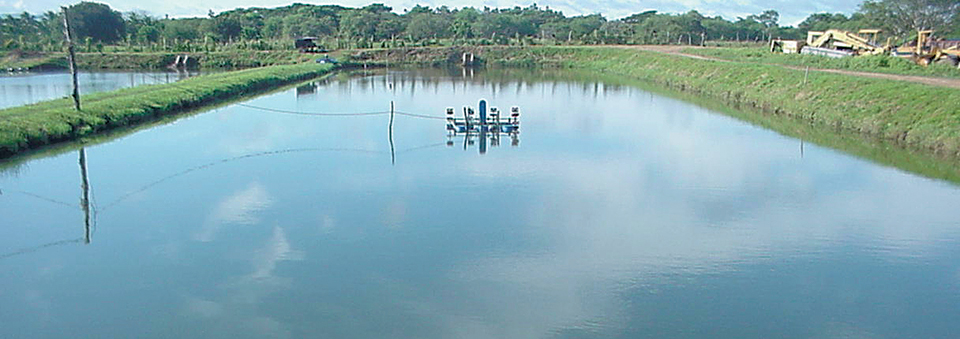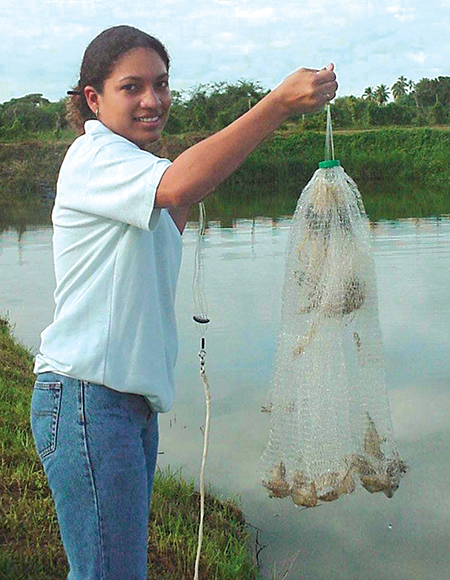
Trial ponds used paddlewheel aeration to help maintain dissolved oxygen levels.Shrimp farmers in Panama who are looking for alternatives to improve production in the presence of White Spot Syndrome Virus have tried different strategies, including freshwater systems. At the end of 2001, Costa Sol Comercial, S.A., a commercial tilapia farm with 0.8 to 2.5 ppt salinity water in Chitre, Herrera, performed a successful trial with shrimp that led to additional stocking.
Pond preparation

Two earthen ponds (C1, 1,710 square meters; and C3, 1,800 square meters) were used in the trial. After sun drying for a week, calcium hydroxide (CaOH) was applied at 454 kilograms per hectare.
Ponds were filled with water filtered through a 160-μ mesh. No additional water was added during the study, except at 60 days to replace that lost, mainly through evaporation. One 2-hp paddlewheel aerator was used in each pond to help maintain dissolved oxygen levels above 3.5 milligrams per liter.
Seedstock
Litopenaeus vannamei postlarvae (PL15-16) from a local hatchery arrived at the farm in 8-ppt salinity water, and were acclimated to 1.2 ppt over seven hours using a 10-cubic-meter tank and water from the experimental ponds. After acclimation, the PL remained in this tank for the next two days. The animals were then stocked at 25 and 30 PL per square meter in C1 and C3, respectively.
Feed
Initially, a 1/16” commercial pelleted feed with 30 percent crude protein for intensive systems was used to feed the stocked animals. After 30 days, it was replaced by another commercial, intensive feed – 3/32”, with 25 percent crude protein and 3 percent squid liver meal.
Feed was distributed by manual broadcasting four times each day: three times during daylight hours (50 percent of daily ration), and once during the night (remaining 50 percent). Two feed trays were used in each pond to monitor and adjust feed consumption.
Molasses was applied every day to promote the development of heterotrophic bacteria. Applications based on the amount of pelleted feed used began at 1 pound per day per pond. By the end of the trial, 4 pounds per day per pond were being applied.
Sampling
The first shrimp sampling was carried out 26 days after stocking, and then repeated weekly. Each time, 100 animals were collected from each pond, and individually measured and weighed so that size frequency distributions could be determined.
Water quality
Water-quality parameters were determined through regular sampling during the production cycle. Samples were analyzed at the Estuarine Station Enrique Enseñat of the Nacional Aquaculture Directorate. Table 1 shows the mean values measured for various water parameters.
Athanasiadis, Water-quality parameters monitored during production trial, Table 1
| Parameter | Mean Value |
|---|---|
| pH | 7.8 |
| Temperature (° C) | 29 |
| Alkalinity (mg/l) | 91 |
| Salinity (ppt) | 0.8-1.2 |
| Ammonia | 0 |
| Dissolved oxygen (mg/l) | > 3.5% |
Production
The ponds were harvested 91 days after stocking, with mean shrimp weights of 15.09 and 13.49 grams for ponds C1 and C3, respectively. Total harvested biomass was about 500 kg for pond C1 and 363 kg for pond C3, representing 2,917 and 1995 kilograms per hectare, respectively. Feed-conversion ratios were 1.4:1 for pond C1 and 1.8:1 for pond C3. Survival rates were 77 percent for C1 and 49.9 percent for C3. No signs of disease were detected.
Conclusion
The results obtained during this trial were considered excellent, especially at the lower stocking density. Based on these results, 22 ponds with a total area of 4.56 ha were stocked for further production.
(Editor’s Note: This article was originally published in the June 2002 print edition of the Global Aquaculture Advocate.)
Now that you've finished reading the article ...
… we hope you’ll consider supporting our mission to document the evolution of the global aquaculture industry and share our vast network of contributors’ expansive knowledge every week.
By becoming a Global Seafood Alliance member, you’re ensuring that all of the pre-competitive work we do through member benefits, resources and events can continue. Individual membership costs just $50 a year. GSA individual and corporate members receive complimentary access to a series of GOAL virtual events beginning in April. Join now.
Not a GSA member? Join us.
Authors
-
Hugo Pérez Athanasiadis
Costa Sol Comercial, S.A.
Entrega General
Chitre, Herrera
Republica de Panamá[116,101,110,46,111,102,110,105,115,64,97,104,116,97,112,97,104]
-
Deris Carlina García Chávez
Costa Sol Comercial, S.A.
Entrega General
Chitre, Herrera
Republica de Panamá
Tagged With
Related Posts

Intelligence
Current production, challenges and the future of shrimp farming
At the Guatemalan Aquaculture Symposium in Antigua, the focus was shrimp farming in the region: production, nutrition, health management and markets.

Health & Welfare
Panama demo shows botanical extracts improve shrimp productivity
Maintaining a favorable gut microflora in shrimp can help minimize the impacts of diseases and maximize digestive efficiency. Phytobiotic feed additives modulate microflora in shrimp toward a composition that favors beneficial bacteria and inhibits pathogenic microorganisms.

Responsibility
Going deep on offshore aquaculture
Open-ocean aquaculture, the “new kid on the block” in the rapidly growing aquaculture industry, was examined at a California Academy of Sciences event. New contributor Twilight Greenaway reports.

Health & Welfare
Shrimp postlarvae: Know your starting point
Shrimp aquaculture could improve its position through more accurate and consistent identification and counting of postlarvae.


